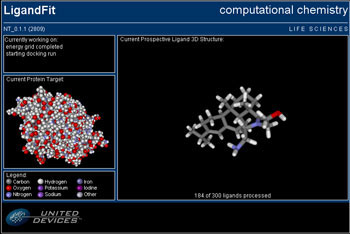 by Preston MacDougall March 11, 2006
The answer is computer screensavers. Ostensibly prolonging the life of the computer screen I was watching, I have been mesmerized by toasters with wings, found absolutely nothing intelligent hidden in radio telescope data, and scored a few hits in the fight against cancer. The latter program - which searches the infinitely vast "molecular space" for suitably sized drug candidates to treat a variety of cancers - is the only one that my family has installed on our latest home computer. And, as Carl Sagan might have said, we are not alone.
Launched in April of 2001, at last count, over 3.4 million computers have downloaded software that accepts batches of its assigned organic molecules over the internet, and simulates their "docking" on known active sites of 12 proteins that biochemists believe are key to the treatment of multiple forms of cancer. After computing the "fit" of each molecule, in all possible docking orientations, your computer will then automatically e-mail the results to Oxford. A good fit is a "hit". All totaled, about 500,000 years of CPU time have been clocked searching for promising leads among 3.5 billion molecules. You might imagine that unions of organic chemists, if there were such a thing, would be picketing over this usurpation of their highly valued skill. Far from it. You see, it takes a lot of time to synthesize a non-trivial organic compound from what is on the shelf, or in the stockroom. Very often the chemist must try numerous well-traveled synthetic pathways, with numerous return trips to the drawing board, before finding one that leads to the desired product, with a substantial yield. Imagine the disappointment, then, when our intrepid chemist is told that biological assays report that either the drug is frighteningly toxic, or that it has no measurable effect on cells, cancerous or otherwise. One down, 3,499,999,999 more to go. Computational screening of molecular dead-enders has been a blessing not a curse to organic chemistry. It is not only a time-saver, but also cuts down tremendously on the chemical waste that must be properly, and expensively, disposed of. In fact, it has been my experience that the only community of scientists that has embraced computers as lovingly as nuclear weapons designers has been that of organic chemists. Graham Richards, debonair professor and current chair of the Department of Chemistry at Oxford, has long been a trailblazer in computational organic chemistry, dating back to the 60s when entering data into a computer involved punching holes in paper. One of his books, "Quantum Pharmacology", is on my bookshelf, and considering that it was published in 1977, can safely be labeled "visionary". Still, I doubt that even Dr. Richards, back in 1977, could have imagined the size and scope of the Intel/United Devices project that is currently searching for anti-cancer drugs. Somewhere along the line though, he did imagine it. His brainchild has become the world's largest computational research project. I tell all of my students about it, and hope that they have helped promote its growth. While being mesmerized, they will learn something about how drugs interact with proteins in our bodies, and a lot about how computers can augment bench research. If you have a PC, and are interested in doing something to fight cancer, besides donating money, you don't have to work in a research lab. If you Google the phrase "screensaver lifesaver" your first hit will be the homepage for the Oxford project. There you can download the screensaver, for free, and learn about which cancers have been targeted, and how the drugs that are to be discovered should have their effect. I believe that flying toasters are now extinct (at least I haven't spotted any for well over ten years now). And even after Howard Stern switched to satellite broadcasting, there is still no sign of extra-terrestrial intelligence among the radio waves. There have been, however, numerous "hits" turned in by computers that were volunteered in the Screensaver Lifesaver project. The most recent news from Oxford is that three promising leads for new and powerful drugs targeting pancreatic cancer were identified, and are now being synthesized by organic chemists, who are probably very optimistic. I know that Graham Richards is.
On the Web:
Publish A Letter on SitNews Read Letters/Opinions Submit A Letter to the Editor
|
||
